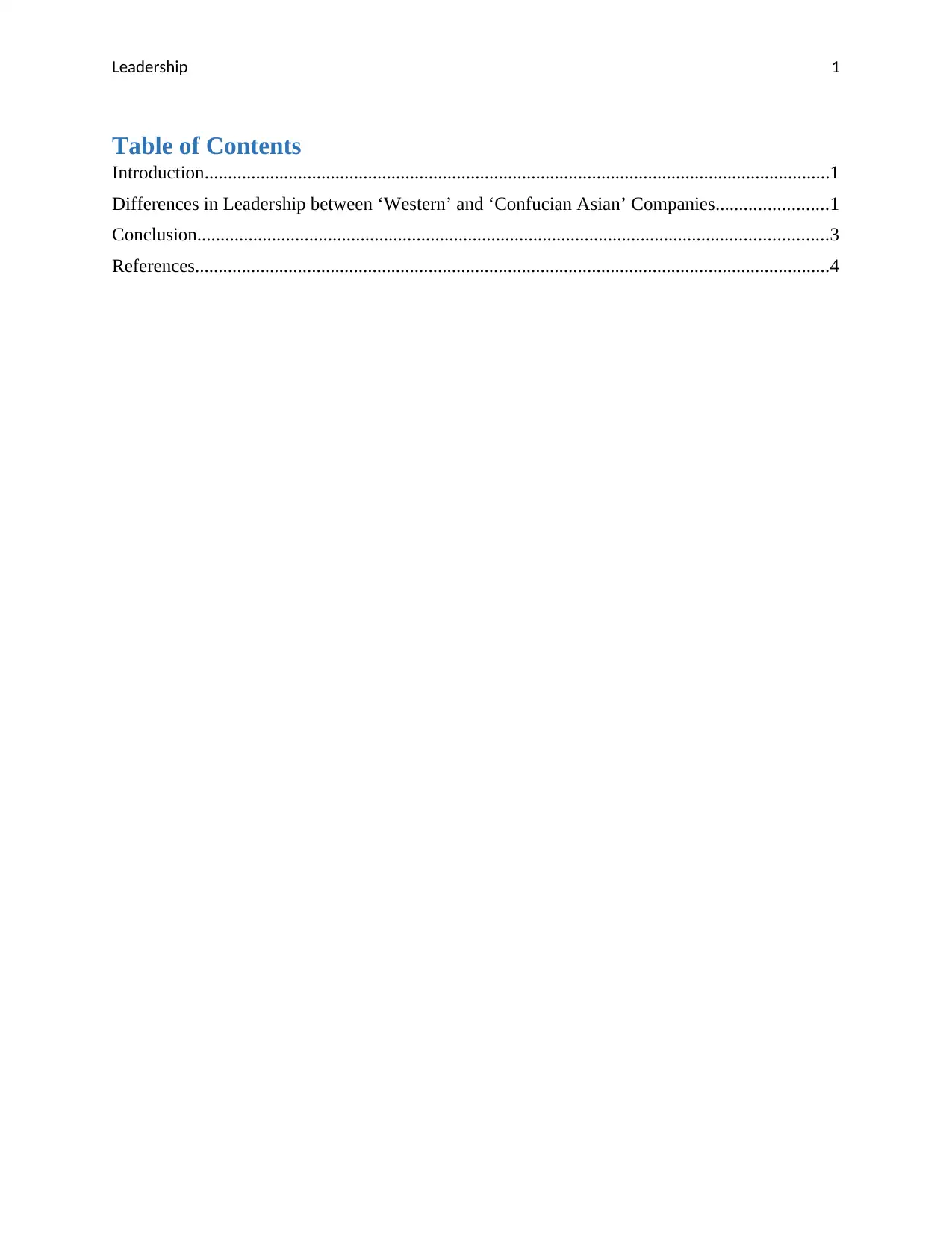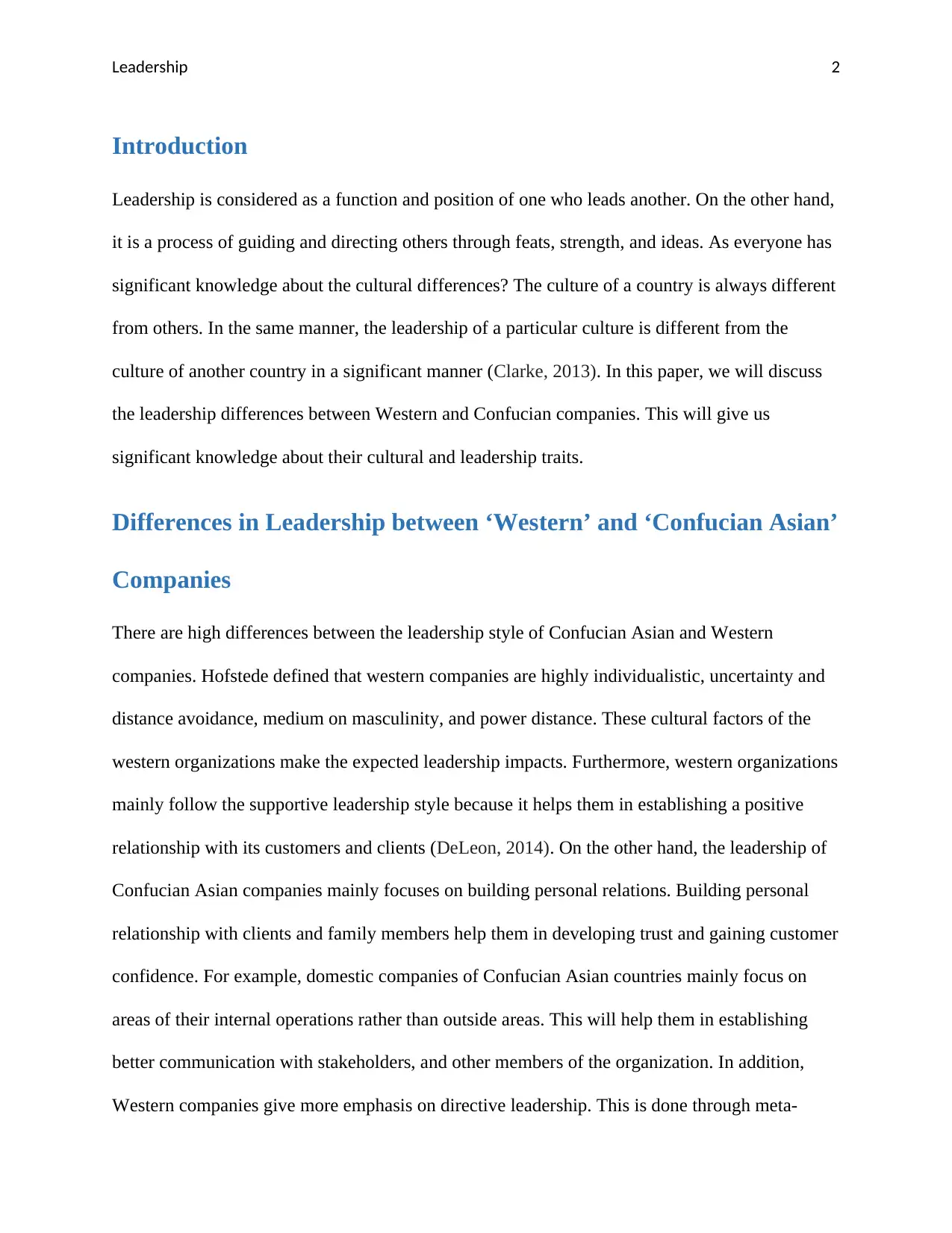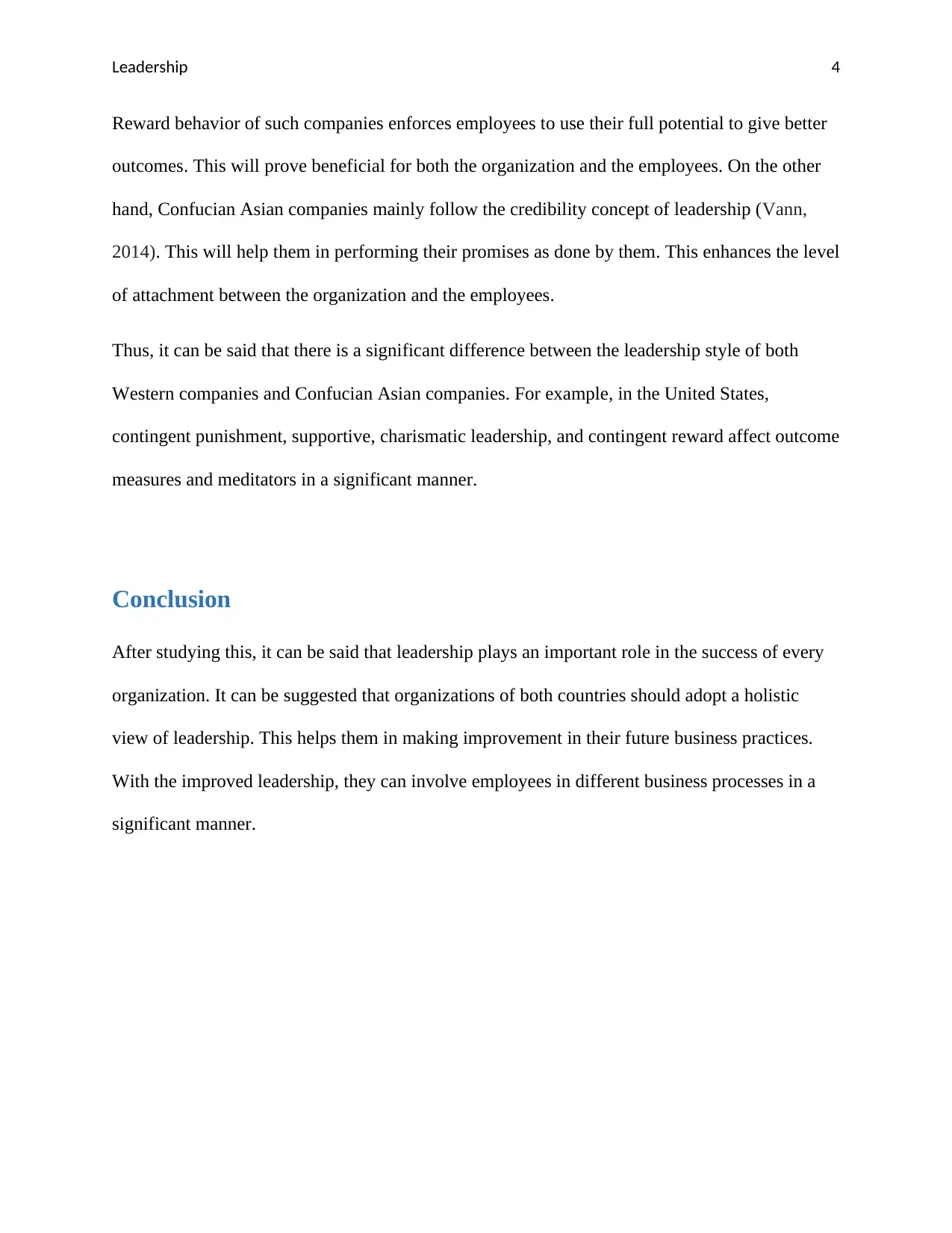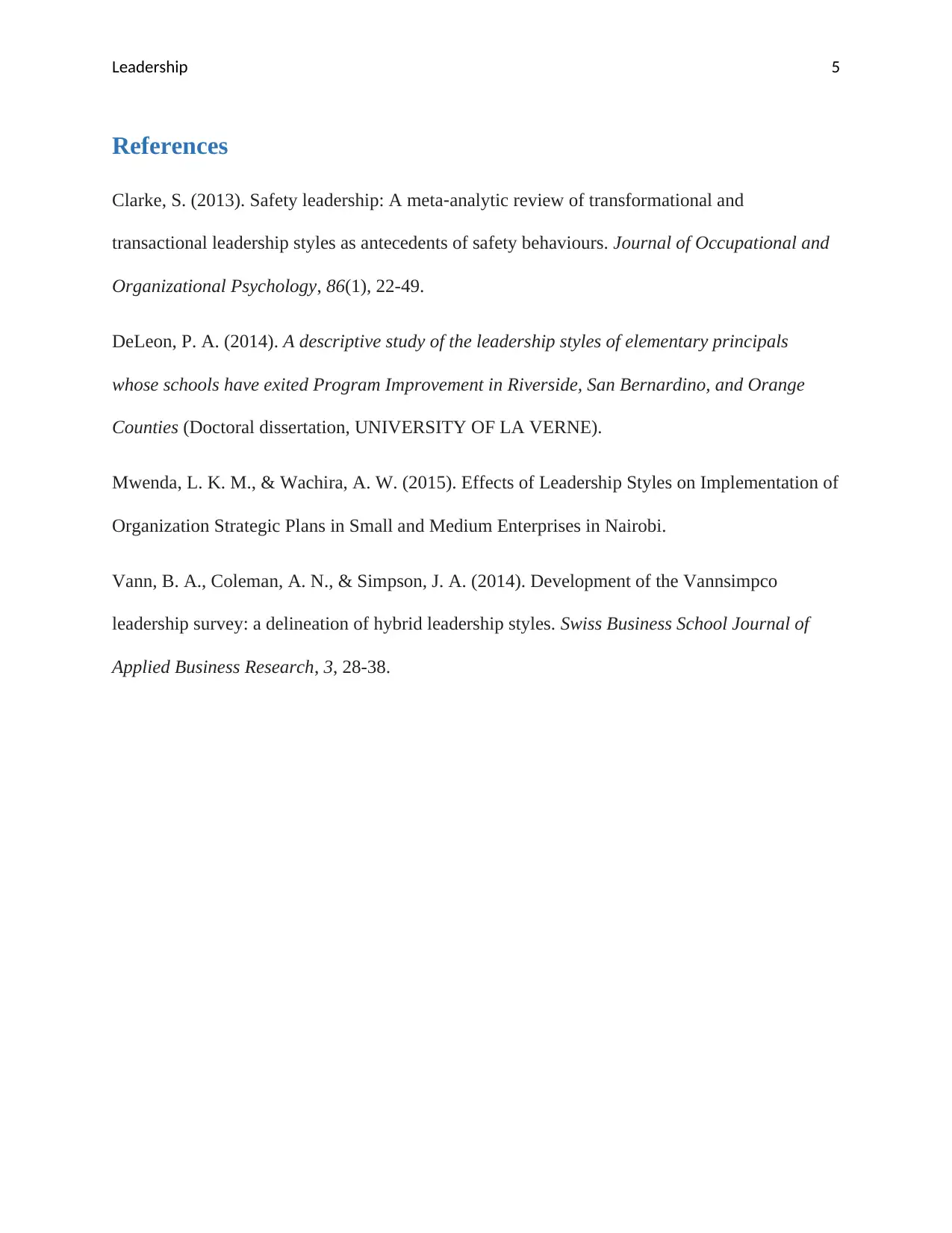Analyzing Leadership Styles: Western and Confucian Asian Companies
VerifiedAdded on 2019/09/20
|6
|1035
|164
Essay
AI Summary
This essay provides a comparative analysis of leadership styles in Western and Confucian Asian companies. It explores the differences in leadership approaches, including directive versus participative leadership, and the impact of cultural factors on organizational practices. The essay highlights the individualism of Western companies and the emphasis on personal relationships and collective interest in Confucian Asian firms. It discusses the use of contingent rewards and punishment in Western companies, contrasting it with the credibility-based leadership in Confucian Asian organizations. The conclusion emphasizes the importance of adopting a holistic view of leadership to improve business practices and enhance employee involvement.

Running Head: Leadership
Western and Confucian Asian Companies
Leadership
Western and Confucian Asian Companies
Leadership
Paraphrase This Document
Need a fresh take? Get an instant paraphrase of this document with our AI Paraphraser

Leadership 1
Table of Contents
Introduction......................................................................................................................................1
Differences in Leadership between ‘Western’ and ‘Confucian Asian’ Companies........................1
Conclusion.......................................................................................................................................3
References........................................................................................................................................4
Table of Contents
Introduction......................................................................................................................................1
Differences in Leadership between ‘Western’ and ‘Confucian Asian’ Companies........................1
Conclusion.......................................................................................................................................3
References........................................................................................................................................4

Leadership 2
Introduction
Leadership is considered as a function and position of one who leads another. On the other hand,
it is a process of guiding and directing others through feats, strength, and ideas. As everyone has
significant knowledge about the cultural differences? The culture of a country is always different
from others. In the same manner, the leadership of a particular culture is different from the
culture of another country in a significant manner (Clarke, 2013). In this paper, we will discuss
the leadership differences between Western and Confucian companies. This will give us
significant knowledge about their cultural and leadership traits.
Differences in Leadership between ‘Western’ and ‘Confucian Asian’
Companies
There are high differences between the leadership style of Confucian Asian and Western
companies. Hofstede defined that western companies are highly individualistic, uncertainty and
distance avoidance, medium on masculinity, and power distance. These cultural factors of the
western organizations make the expected leadership impacts. Furthermore, western organizations
mainly follow the supportive leadership style because it helps them in establishing a positive
relationship with its customers and clients (DeLeon, 2014). On the other hand, the leadership of
Confucian Asian companies mainly focuses on building personal relations. Building personal
relationship with clients and family members help them in developing trust and gaining customer
confidence. For example, domestic companies of Confucian Asian countries mainly focus on
areas of their internal operations rather than outside areas. This will help them in establishing
better communication with stakeholders, and other members of the organization. In addition,
Western companies give more emphasis on directive leadership. This is done through meta-
Introduction
Leadership is considered as a function and position of one who leads another. On the other hand,
it is a process of guiding and directing others through feats, strength, and ideas. As everyone has
significant knowledge about the cultural differences? The culture of a country is always different
from others. In the same manner, the leadership of a particular culture is different from the
culture of another country in a significant manner (Clarke, 2013). In this paper, we will discuss
the leadership differences between Western and Confucian companies. This will give us
significant knowledge about their cultural and leadership traits.
Differences in Leadership between ‘Western’ and ‘Confucian Asian’
Companies
There are high differences between the leadership style of Confucian Asian and Western
companies. Hofstede defined that western companies are highly individualistic, uncertainty and
distance avoidance, medium on masculinity, and power distance. These cultural factors of the
western organizations make the expected leadership impacts. Furthermore, western organizations
mainly follow the supportive leadership style because it helps them in establishing a positive
relationship with its customers and clients (DeLeon, 2014). On the other hand, the leadership of
Confucian Asian companies mainly focuses on building personal relations. Building personal
relationship with clients and family members help them in developing trust and gaining customer
confidence. For example, domestic companies of Confucian Asian countries mainly focus on
areas of their internal operations rather than outside areas. This will help them in establishing
better communication with stakeholders, and other members of the organization. In addition,
Western companies give more emphasis on directive leadership. This is done through meta-
⊘ This is a preview!⊘
Do you want full access?
Subscribe today to unlock all pages.

Trusted by 1+ million students worldwide

Leadership 3
analysis and different measures of consumer satisfaction. Directive leadership helps them in
building strong relationships with their followers and shareholders. But, directive leadership is
not suitable for every business situation. It may have a negative influence on clients and
characteristics of individual followers. Workers who are highly experienced, professional,
talented, and educated will have less need for traditional directive leadership behavior in
performing their assigned functions. On the other hand, Confucian Asian companies mainly
follow such type of leadership style which respects for authority and freedom of others. This will
help the organization in getting more participation from the employees and customers.
Moreover, Confucian Asian companies focus such motivational leadership concept which
promotes collective interest, and group benefits (Mwenda, 2015). Due to such type of leadership
style, they are able to attract a large number of talented employees towards its operations. People
like to be the part of such organizations where collective interest and group benefits are
promoted in a significant manner. But, in Western companies mostly supports participative
management processes. This helps them in enhancing the participation level from employees in
different decision-making processes of the organization. This ultimately improves the quality of
decision which further benefits the Western organizations. In addition, Confucian Asian
companies are following the concept of relationship driven leadership. With the help of this
leadership concept, they are able to create healthy relations which are necessary of availing
market opportunities. Credibility and healthy relationship are considered the base of every single
organization. If these are satisfied, they can survive in their potential market for a long time.
Furthermore, Western companies mainly also follow the punishment and rewards contingent
approach to improving individual performance. This will help them in achieving high motivation
and individualism which further helps them in gaining predetermined goals of the organization.
analysis and different measures of consumer satisfaction. Directive leadership helps them in
building strong relationships with their followers and shareholders. But, directive leadership is
not suitable for every business situation. It may have a negative influence on clients and
characteristics of individual followers. Workers who are highly experienced, professional,
talented, and educated will have less need for traditional directive leadership behavior in
performing their assigned functions. On the other hand, Confucian Asian companies mainly
follow such type of leadership style which respects for authority and freedom of others. This will
help the organization in getting more participation from the employees and customers.
Moreover, Confucian Asian companies focus such motivational leadership concept which
promotes collective interest, and group benefits (Mwenda, 2015). Due to such type of leadership
style, they are able to attract a large number of talented employees towards its operations. People
like to be the part of such organizations where collective interest and group benefits are
promoted in a significant manner. But, in Western companies mostly supports participative
management processes. This helps them in enhancing the participation level from employees in
different decision-making processes of the organization. This ultimately improves the quality of
decision which further benefits the Western organizations. In addition, Confucian Asian
companies are following the concept of relationship driven leadership. With the help of this
leadership concept, they are able to create healthy relations which are necessary of availing
market opportunities. Credibility and healthy relationship are considered the base of every single
organization. If these are satisfied, they can survive in their potential market for a long time.
Furthermore, Western companies mainly also follow the punishment and rewards contingent
approach to improving individual performance. This will help them in achieving high motivation
and individualism which further helps them in gaining predetermined goals of the organization.
Paraphrase This Document
Need a fresh take? Get an instant paraphrase of this document with our AI Paraphraser

Leadership 4
Reward behavior of such companies enforces employees to use their full potential to give better
outcomes. This will prove beneficial for both the organization and the employees. On the other
hand, Confucian Asian companies mainly follow the credibility concept of leadership (Vann,
2014). This will help them in performing their promises as done by them. This enhances the level
of attachment between the organization and the employees.
Thus, it can be said that there is a significant difference between the leadership style of both
Western companies and Confucian Asian companies. For example, in the United States,
contingent punishment, supportive, charismatic leadership, and contingent reward affect outcome
measures and meditators in a significant manner.
Conclusion
After studying this, it can be said that leadership plays an important role in the success of every
organization. It can be suggested that organizations of both countries should adopt a holistic
view of leadership. This helps them in making improvement in their future business practices.
With the improved leadership, they can involve employees in different business processes in a
significant manner.
Reward behavior of such companies enforces employees to use their full potential to give better
outcomes. This will prove beneficial for both the organization and the employees. On the other
hand, Confucian Asian companies mainly follow the credibility concept of leadership (Vann,
2014). This will help them in performing their promises as done by them. This enhances the level
of attachment between the organization and the employees.
Thus, it can be said that there is a significant difference between the leadership style of both
Western companies and Confucian Asian companies. For example, in the United States,
contingent punishment, supportive, charismatic leadership, and contingent reward affect outcome
measures and meditators in a significant manner.
Conclusion
After studying this, it can be said that leadership plays an important role in the success of every
organization. It can be suggested that organizations of both countries should adopt a holistic
view of leadership. This helps them in making improvement in their future business practices.
With the improved leadership, they can involve employees in different business processes in a
significant manner.

Leadership 5
References
Clarke, S. (2013). Safety leadership: A meta‐analytic review of transformational and
transactional leadership styles as antecedents of safety behaviours. Journal of Occupational and
Organizational Psychology, 86(1), 22-49.
DeLeon, P. A. (2014). A descriptive study of the leadership styles of elementary principals
whose schools have exited Program Improvement in Riverside, San Bernardino, and Orange
Counties (Doctoral dissertation, UNIVERSITY OF LA VERNE).
Mwenda, L. K. M., & Wachira, A. W. (2015). Effects of Leadership Styles on Implementation of
Organization Strategic Plans in Small and Medium Enterprises in Nairobi.
Vann, B. A., Coleman, A. N., & Simpson, J. A. (2014). Development of the Vannsimpco
leadership survey: a delineation of hybrid leadership styles. Swiss Business School Journal of
Applied Business Research, 3, 28-38.
References
Clarke, S. (2013). Safety leadership: A meta‐analytic review of transformational and
transactional leadership styles as antecedents of safety behaviours. Journal of Occupational and
Organizational Psychology, 86(1), 22-49.
DeLeon, P. A. (2014). A descriptive study of the leadership styles of elementary principals
whose schools have exited Program Improvement in Riverside, San Bernardino, and Orange
Counties (Doctoral dissertation, UNIVERSITY OF LA VERNE).
Mwenda, L. K. M., & Wachira, A. W. (2015). Effects of Leadership Styles on Implementation of
Organization Strategic Plans in Small and Medium Enterprises in Nairobi.
Vann, B. A., Coleman, A. N., & Simpson, J. A. (2014). Development of the Vannsimpco
leadership survey: a delineation of hybrid leadership styles. Swiss Business School Journal of
Applied Business Research, 3, 28-38.
⊘ This is a preview!⊘
Do you want full access?
Subscribe today to unlock all pages.

Trusted by 1+ million students worldwide
1 out of 6